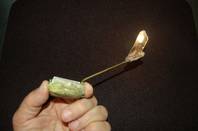Friday, Oct. 12, 2012 | 2 a.m.
As the old saying goes, “Where there’s a will, there’s a way.”
In Las Vegas and other gambling hubs, that certainly holds true when it comes to cheating. Some swindles have been successful; others failed miserably.
But it doesn’t keep people from trying.
“There’s always a temptation to cheat whenever there’s money,” said Howard Schwartz, who, as a former owner of the Gambler’s Book Club, keeps tabs on the gaming industry. “People are always looking for an edge.”
When the Global Gaming Expo rolled into town last week, it included several sessions devoted to security and surveillance in casinos. A description of one such session, “Finding Fraud: Current and Future Trends in the Gaming Industry,” noted that, “Scams and thefts can take many forms, but they all involve fraud in one way or another.”
Despite technology advances through the years, con artists have used phones, computers and magnets, among other tactics, to gain a winning advantage, Schwartz said.
Here are a few notable scams that have been used to swindle money from casinos since the 1970s:
-
Slot machine scams by Dennis Nikrasch
Dennis Nikrasch, who has been labeled the “mastermind of the biggest slot-cheating schemes in Nevada history,” beat the system by using a slot machine key. Bill Zender, a former Nevada Gaming Control agent who is now a gaming consultant, said, in the late 1970s and early '80s, Nikrasch and his associates would make an imprint of a slot machine cabinet key while distracting slot machine mechanics. Later, they would use the key to open the machine and rig the electronic machines, setting the reels on a winning jackpot combination.
After being caught and serving one prison sentence, Nikrasch returned to use more sophisticated methods to cheat the slot machines, Zender said. According to a story in the Las Vegas Sun archives, Nikrasch, who later changed his last name to McAndrew, netted about $16 million from his slot machine scams. He served two prison sentences.
Nikrasch’s scams earned him entry into Nevada’s “black book,” a list of people banned from casinos, in 2004, according to Sun archives.
-
Switching cards in blackjack
Switching cards in blackjack requires a team effort. Two players look at their blackjack hands and decide which cards to switch, Zender said.
Zender said two men, Robert Ailse and John Dixon, began using this strategy in the early 1980s. They would sit side-by-side and remove one card from their hand while placing the other card under their table wager to simulate two cards, Zender said.
Next, they would exchange the cards they removed and slip the received card back under their wager with the other card, Zender said. The goal was to make one hand as strong as possible.
The scam often involved others acting as lookouts or barriers, blocking the quick cheat from view.
-

Slot machine scams by Tommy Carmichael
Tommy Carmichael, who has a spot in Nevada’s black book, is known as the inventor of multiple cheating devices for slot machines.
One of those devices that Carmichael invented was a light wand designed to trick slot machines into releasing more coins, said George Joseph, a gaming consultant. The approximately 7-inch wand that involved a battery, magnet and miniature light would enable people to steal a couple hundred dollars at a time when inserted up the shoot of a slot machine, Joseph said.
Carmichael used knowledge gained from his days running a television repair shop in Tulsa, Okla., to create the cheating devices, Joseph said.
According to the Nevada Gaming Control Board, Carmichael was convicted of cheating twice in Nevada and once in New Jersey. He received a federal conviction in 2000 for his role as a principal member of a nationwide cheating operation.
He’s listed as a “substantial threat to the gaming industry” on the gaming board’s excluded persons list.
-
Dice sliding in craps
Cheats often practice dice sliding, or dice shooting, to beat the game of craps by narrowing the possible dice combinations, Zender said.
The scam works like this: A shooter throws the dice in a way that causes one die to slide down the table without turning over. Meanwhile, the other die bounces down the table randomly. Because the one die slides and never turns, it cuts the possible dice combinations from 36 to 6.
In turn, bettors will place bets on those six possible outcomes, Zender said. The scam often involves two people or more to block the method from view.
Last October, Wynn Las Vegas filed a lawsuit in Clark County District Court against two gamblers from Argentina who allegedly used dice sliding to win $700,000.
-
The Tran Organization
By the time the group was brought to justice, the Tran Organization, which cheated in baccarat, had swindled more than $15 million from casinos throughout the United States and Canada in the early 2000s.
The San Diego-based group enlisted the help of casino dealers and supervisors through bribes to perform false shuffles during baccarat games, Zender said. Before the false shuffles, conspirators would record the order of the cards, thus allowing them to win multiple hands.
The criminal operation also used specially developed computer programs, concealed microphones and transmitters to pull off cheating in casinos, according to an FBI report.
In Las Vegas, the Tran Organization struck Palace Station and the Monte Carlo. By early 2011, 42 defendants had pleaded guilty to charges relating to the casino-cheating conspiracy.
-
The "Cutters" group
A Malaysian group in 2010 began beating casinos near the Pacific Rim using a concealed video camera to record card order, Zender said.
The group, which came to be known as the “Cutters,” would hide a tiny video camera in a jacket sleeve to record the order of cards in an eight-deck baccarat game, Zender said. The recording would occur during the deck-cutting process after the cards had been shuffled.
The cheater would appear to innocently drag a plastic cut card across the top of the deck, Zender said. It’s a cover for what’s actually happening — the cut card hides a small device attached to an index finger that turns up the index corners of the cards so the order can be recorded.
The group is suspected of scamming Las Vegas casinos out of more than $1 million in January 2011.



Join the Discussion:
Check this out for a full explanation of our conversion to the LiveFyre commenting system and instructions on how to sign up for an account.
Full comments policy